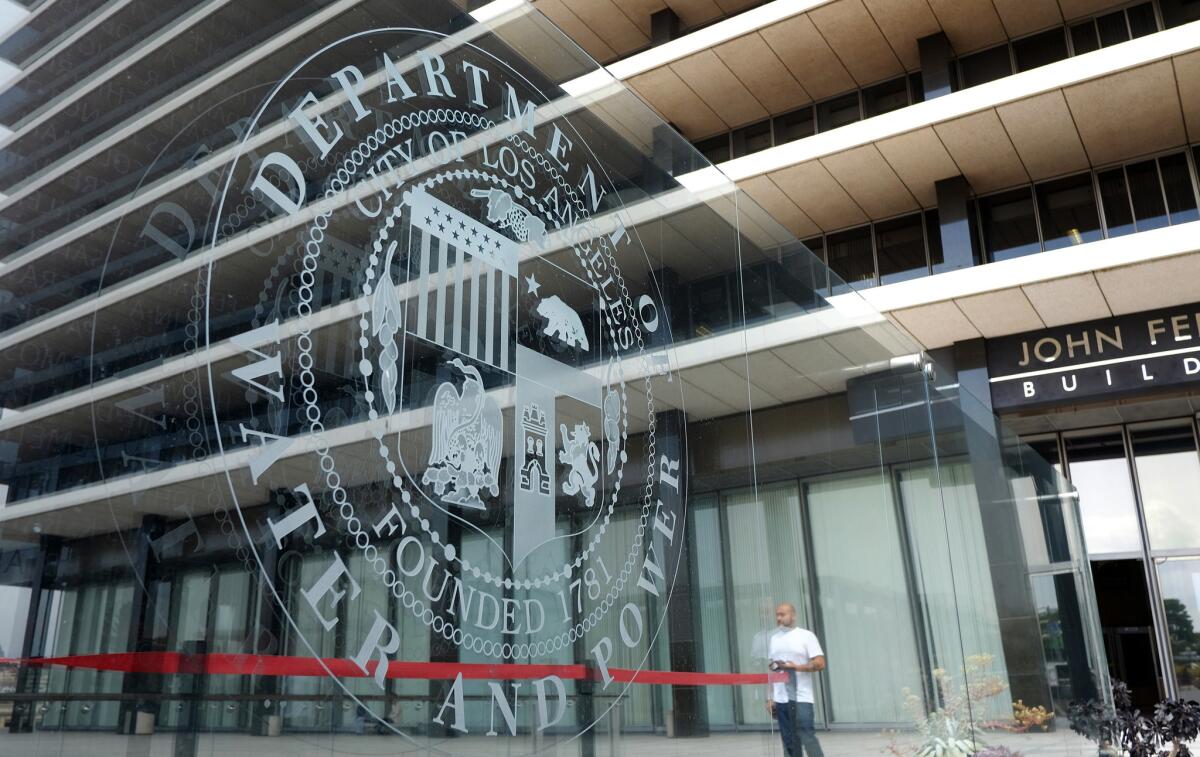Op-Ed: DWP ratepayers may get soaked again

- Share via
Angelenos could be looking at higher water and energy bills again. The Los Angeles Department of Water and Power is expected to propose a $2.2-billion plan to modernize the city’s pipes, pumping stations, reservoirs and aqueduct. Rather than burdening ratepayers with another rate increase, DWP should instead help finance the project by cutting employee pay.
------------
FOR THE RECORD
A March 30 Op-Ed on Department of Water and Power salaries stating that L.A. residents in January paid 57% more for electricity than the national average was incorrect, because the data also covered customers in Riverside and Orange counties. A better calculation, using the standard residential tier 1 DWP rate and data from the U.S. Energy Information Administration, shows L.A. residents paid 20% more. Also, the comparison of what DWP workers earn in three fields with what private-sector L.A. workers earn in the same fields was misleading. Average base pay, without overtime, for custodians is $26,810 (non-DWP), $55,691 (DWP); for plumbers, pipefitters and steamfitters is $65,350 (non-DWP), $102,587 (DWP); and for security guards is $26,640 (non-DWP), $65,778 (DWP).
------------
As detailed in a recent paper by TransparentCalifornia.com, DWP employee pay is up to three times greater than that of its private-sector counterparts. The average full-time, year-round DWP employee made $114,941 in 2013. This is despite providing a level of service that in 2011 had it ranked the 13th most hated company in the nation in one survey.
Inflated pay at DWP is not new. The L.A. Times, Bloomberg and the Los Angeles Daily News have reported on it for years, the latter going so far as to include a prominent editor’s note: “If you read only one story today, I hope it will be this one. The DWP’s bloated salaries, poor management and soaring rates are the most glaring example of what’s wrong with Los Angeles.” That was in 2007.
As the Daily News reported then, 13% of the utility’s 8,880 employees were paid at least $100,000. Now, 53% of its 10,299 employees are paid at least that amount.
DWP custodians made an average $70,893 in total pay in 2013, compared with the Los Angeles market average for janitors and cleaners of $26,810, as reported by the Bureau of Labor and Statistics. DWP plumbers earned an average of $121,450, compared with the BLS average wage for Los Angeles plumbers, pipefitters and steamfitters of $65,350. DWP security officers earned $87,021 — more than triple the $26,640 BLS average for Los Angeles security guards.
Of course, living in the L.A. area on an annual income below $30,000 is difficult to impossible. But this is just another reason why imposing rate hikes on low-income workers to help fund pay packages up to triple their own should be addressed.
DWP spokesman Joe Ramallo, who received $232,000 total pay in 2013, responded to such pay discrepancies by saying the comparisons don’t take into account all the factors that can lead to differences. In some past analyses, he may have had a point.
But the Transparent California study matched DWP employees by job title, responsibility and requirements with their Los Angeles-area counterparts as determined by the BLS.
Additionally, the study compared the value of benefit contributions, not just pay. DWP employees contribute 6% of their salaries to their pensions — about the same as the 6.2% that private-sector employees contribute to Social Security.
But that’s where the pension similarities end. DWP employees receive pensions that are at least triple the value of what typical private-sector employees can expect from Social Security.
And if the widespread criticism of systemic billing errors, horrific customer service, overcharges and lack of accountability for millions of dollars in two controversial nonprofit trusts is any indication, DWP employees are not outperforming their private-sector counterparts to earn such inflated pay and pensions.
Reform is possible. In the public outcry that followed The Times’ 2013 reports of the agency’s unlimited sick-leave policy, DWP’s operating contract was modified. This policy was reined in, but little was done to reform overall compensation.
Meanwhile, residents of Los Angeles face yet another rate hike, only a couple of years after an 11.1% increase in electricity rates. DWP officials have recently suggested that they plan to seek recurring rate hikes of at least 2% per year beginning this year to fix infrastructure. But CityWatch is reporting that Angelenos should expect rate hikes of 5% to 8% a year, for each of the next five years. Residents in January paid 57% more for electricity than the national average, according to the BLS.
These higher prices act as a regressive tax on the poor, who are forced to spend a proportionally larger share of their income on energy than their wealthy neighbors. With the growing concern about income inequality, policymakers should think twice before stacking the deck further against the poor through more rate increases.
Instead, the inflated pay of DWP employees should be brought into the same universe as comparable private-sector salaries to help pay for new department costs.
Robert Fellner is research director at TransparentCalifornia.com, a project of the Nevada Policy Research Institute and California Policy Center.
Follow the Opinion section on Twitter @latimesopinion and Facebook
More to Read
A cure for the common opinion
Get thought-provoking perspectives with our weekly newsletter.
You may occasionally receive promotional content from the Los Angeles Times.










